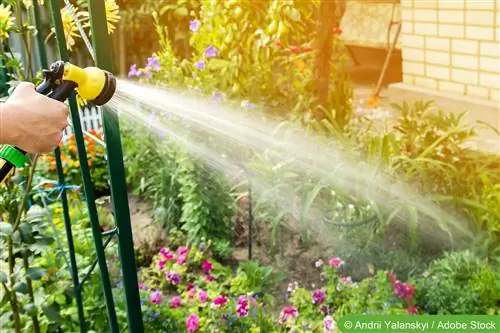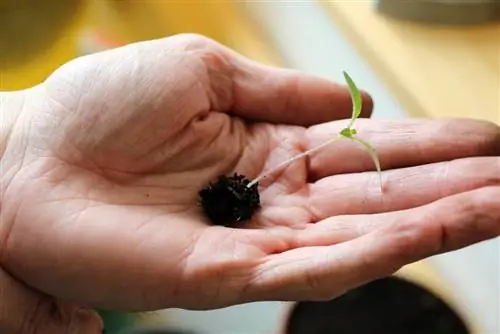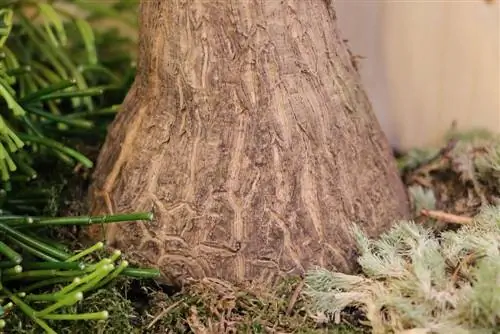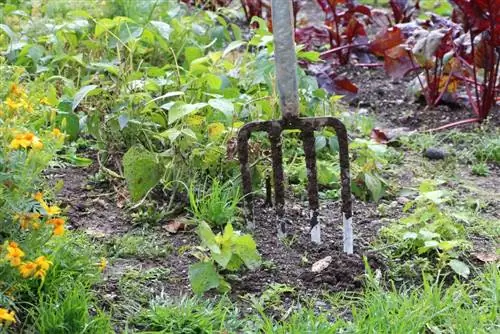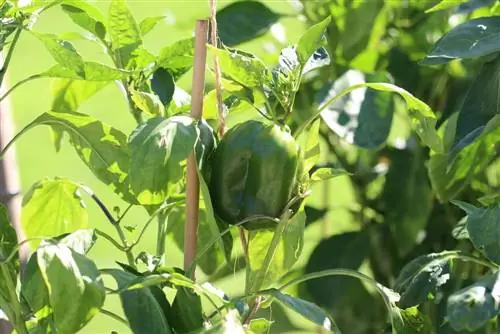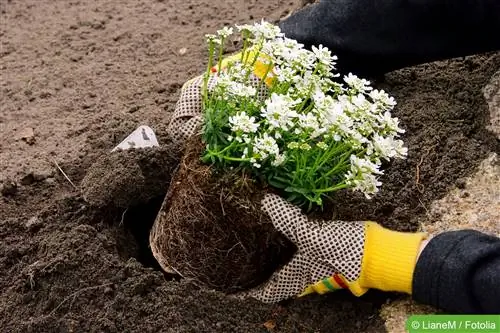- Author admin [email protected].
- Public 2023-12-17 03:39.
- Last modified 2025-01-24 12:45.
July is the month of roses. Most of the roses are now unfolding in their perfect beauty. There are also a lot of things blooming in the perennial bed now. Balcony flowers sway their delicate blossoms in the wind and most of the potted plants have finally decided to bloom.
Gardening in July
- On overcast days or towards the evening you can still plant perennials and other plants in the ground. Watering adequately is now the top priority, the plants are very sensitive to drought. Potted plants and other easily woody plants can now be easily propagated using cuttings. Be sure to place the pots and bowls with the freshly cut cuttings in a shady place.
- Most of the potted plants are now in full bloom and delight us with their colors and scents. However, you should be careful not to mix too many scents on the terrace. This can lead to headaches or even nausea. One scented plant is enough for the terrace. The only exceptions are herbs. There can be a little more of this. To prevent seed formation (unless this is expressly desired), you should also remove the wilted flowers on potted plants.
- Roses can also be propagated very easily from cuttings. Dwarf, bed and climbing roses in particular are happy to allow this. July is the best time for this. Place the rose cuttings directly into the moistened soil in a shady place and, ideally, place an old, clean mason jar over them. They root after just a few weeks, but the rooted rose should remain in this location for 1-2 years. It is important that they are supplied with sufficient and regular water.
- In July, more tall perennials bloom in the garden. To protect them from twisting, you should support them. The supports also prevent them from falling apart during heavy rains. You should now regularly hoe the soil between the perennials and remove weeds. By hoeing the soil is loosened and aerated. This means water reaches the roots more quickly and easily.
- July is the next fertilizer period for roses, herbs and perennials. Heavy-feeding plants are now being fertilized again. It is important to make sure that the soil is moist when applying the fertilizer (preferably after watering). Work fertilizer lightly into the soil. The moisture causes the nutrients to dissolve more quickly and are therefore available to the plants after a short time.
- Fertilizing is also important in the fruit and vegetable garden. It is best to do fertilizing together with watering. July is also harvest month for many types of fruit. Strawberries, raspberries, and some other early fruit varieties can be harvested now. If there is too much, you can make compote or jam. You can make delicious fruit foam for dessert from berries. Let cool in the freezer and enjoy ice cold.
More gardening tips for June
July is usually quite sunny and warm, but can also be rainy. No matter what the weather is like, there is always something to do in the garden. The lawn can now stand a little longer, but, like all other plants, it needs to be watered well in dry phases. The fruit trees need a lot of attention, and the first preparations can be made for overwintering the plants and flowering next year.
Fertilize, water, care
In July the plants need care. It is dry, most plants produce fruit - not only do they need to be watered regularly and generously, but they also need to be fertilized. This applies to potted plants as well as outdoor plants. Beds are only raked and loosened very carefully so as not to injure the plants. However, soil care is still important so that the water does not evaporate so quickly but can be absorbed well. Dry soil is not only quite well sealed on the surface (so rainwater would not be easily absorbed, but would flow over it), but also forms capillary tunnels through which the water evaporates quite quickly.
Annual and biennial flowers
The spring and summer bloomers for next year can be sown in July. This applies to pansies, columbines, forget-me-nots, foxgloves, carnations and mallows. If you have already sown the plants in June (this is also possible), you can prick out the young plants. The beds should be kept loose, well fertilized and watered regularly. This is equally good for seeds and young plants. By the way, you can easily propagate cuttings such as hydrangeas in July. To do this, the plants should be he althy and strong and, if possible, not blooming straight. Make sure that the cutting has the same, if possible, optimal climate as the mother plant - this does not guarantee growth, but increases the chances of success.
Ornamental shrubs and hedges
Many bushes and hedges are slowly withering away. You should remove the wilted flowers so that the plants can produce new flowers instead of fruits. Fruits take away the strength of the plant and prevent many more flowers from forming. This is especially true for remontant roses. Hedges are always trimmed in July and the roses are fertilized for the last time.
By the way, perennials don't need much care in July. Withered flowers should be removed, and tall perennials should be tied up - if this hasn't already happened. You should shape cut hedges properly in July, and don't forget to water the plants in the pot as well as outdoors thoroughly. July is often quite dry.
Fruit trees and bushes
There's a lot going on when it comes to fruit in July. Fruit trees need to be watered, this is particularly important for young trees. The fruit trees receive their last fertilization in July and of course they can be harvested. Currants, gooseberries, late strawberries, cherries and sour cherries, pears, raspberries and clear apples are now ripe. The fruit gets really heavy on the trees, and to prevent the branches from breaking, you should put up fruit tree supports. They provide support for the heavily laden branches, especially when one or two summer thunderstorms shake the trees with strong gusts of wind. If you are worried about your harvest, you can put bird nets over the trees to protect the ripe fruits.
After the harvest, some fruit trees are cut - this mainly affects sour cherries and apricots, which can be harvested in July. Apples, pears and plums can be grafted in cloudy weather. The young shoots of the kiwi are cut back in July so that the plants do not overgrow and put all their strength into growth.
Wine
The wine is far from being ready for harvest, the grapes still need time. But miserliness keeps growing and can still be broken out in July. Stingy shoots have their purpose, they are developed by the plants in the same way as other shoots, they have all the organs like other shoots, although they are a little smaller. It used to be said that stingy shoots absolutely had to be removed. Today we know that this is not the case - miserliness is important and ensures that the grapes can ripen really well. They are actually only removed when they form heavy foliage on the grapes. That would be annoying because it increases the risk of fungal infections. You should only remove stingy shoots if they are too leafy. Heavy foliage growth around the grapes should definitely be removed, and this work takes place in July. When carrying out this work, be careful not to injure the trunk or grapes.
Herbs and vegetables
Most herbs can be harvested in July. If you don't process it fresh, you can freeze or dry it to build up a supply. Carefully loosen the beds so that the moisture in the soil is better retained and water can be absorbed more easily.
You can harvest the first potatoes in July, and some other vegetables such as carrots, radishes, onions, peas, beans and the like may also be ready to harvest.
But you can also sow: carrots and Chinese cabbage, for example. Other vegetables such as zucchini, peppers, cucumbers and tomatoes may be partially ready to harvest. Water the plants regularly and abundantly, because they need a lot of water, especially in the final stage of fruit growth.
Tips for speed readers
- Water all plants regularly and generously, including the lawn.
- Fertilize potted plants and outdoor plants well.
- Rake and loosen the soil in beds carefully but regularly.
- Sow spring and summer bloomers for next year or prick out (if sown in June). Be sure to keep the beds moist and loose and fertilize.
- Propagate cuttings if necessary.
- Remove wilted flowers from perennials and tie up tall-growing perennials.
- Cut hedges into shape.
- Water and fertilize fruit trees.
- Harvest ripe berries and fruit, set up fruit tree supports. If necessary, spread out bird nets.
- Cut sour cherries and apricots after harvest, cut back young kiwi shoots.
- Refine apples, pears and plums in cloudy weather.
- Remove heavy foliage from wine.
- Harvest and process herbs or create supplies.
- Harvest early potatoes and other vegetables.
- Sowing carrots and Chinese cabbage.
- Water all vegetables well, rake the beds carefully and keep the soil loose.

